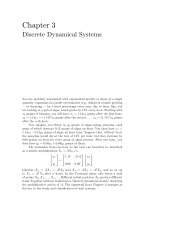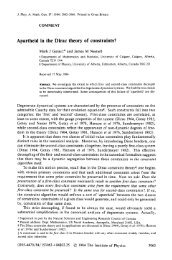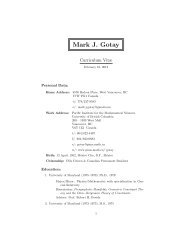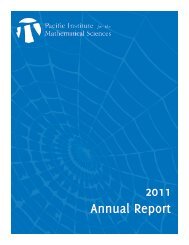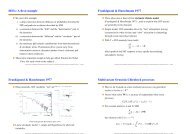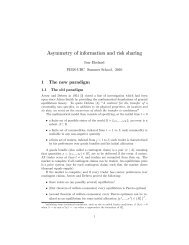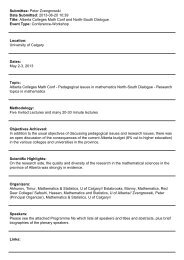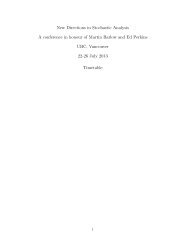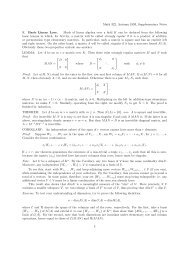19 PRIMA 2013 Abstractscritical slope u x = 1. We show th<strong>at</strong>, for a fixed rel<strong>at</strong>ionof the asymptote <strong>at</strong> x = ±∞, there exists a unique travelingwave solution. Furthermore, such traveling wavesolutions are local <strong>at</strong>tractors. Nearby solutions approachthe traveling wave asymptotically as t → ∞. This is ajoint work with Graziano Guerra, see [3].[1] D. Amadori and W. Shen, Front tracking approxim<strong>at</strong>ionsfor slow erosion, Discrete Contin. Dyn. Syst., 32(2012), no. 5, 1481–1502.[2] R. M. Colombo, G. Guerra, and W. Shen, Lipschitzsemigroup for an integro–differential equ<strong>at</strong>ion for slowerosion, Quart. Appl. M<strong>at</strong>h., 70 (2012), 539–578.[3] G. Guerra, and W. Shen, Existence and Stability ofTraveling Waves for an Integro-differential Equ<strong>at</strong>ion forSlow Erosion Preprint, 2013.[4] W. Shen and T.Y. Zhang, Erosion profile by a globalmodel for granular flow, Arch. R<strong>at</strong>ion. Mech. Anal., 204(2012), no. 3, 837–879.On the existence of Meyer type transonicflows and a degener<strong>at</strong>e change type equ<strong>at</strong>ionZhouping XinThe Chinese University of Hong Kong, Hong Kong, Chinazpxin@ims.cuhk.edu.hkHistorically, two types of smooth steady compressibleirrot<strong>at</strong>ional transonic flows were conjectured for 2-dimensional de Laval nozzles: Taylor type and Meyertype. However, it has known since Lipman Bers th<strong>at</strong> Taylortype transonic flows may not exist in general, whilethe existence of Meyer type transonic flows with suitablephysical boundary condition has been a long standingopen problem. Such a flow is governed by a quasilinearequ<strong>at</strong>ion which changes type and becomes degener<strong>at</strong>eupon crossing sonic st<strong>at</strong>e where the flow may havesingularities. In this talk, I will report some progress onstudies of such problems. First, by investig<strong>at</strong>ing the propertiesstructure of the sonic curve, in particular its exceptionalpoints, for C 2 -smooth transonic flows in a generalnozzle, we show the instability of Taylor type flowsand Meyer type flows with non-empty exceptional points.Then we identify a class of de Laval nozzles and suitablephysical boundary conditions such th<strong>at</strong> Meyer type transonicflow exists with sonic curve everywhere exceptional.Some global properties of such a solution and rel<strong>at</strong>ed openproblems will be discussed.Weakly nonlinear geometric optics for hyperbolicsystems of conserv<strong>at</strong>ion lawsYongqian ZhangFudan University, Chinayongqianz@fudan.edu.cnIn this talk I will present a new approach to analyze thevalid<strong>at</strong>ion of weakly nonlinear geometric optics for entropysolutions of nonlinear hyperbolic systems of conserv<strong>at</strong>ionlaws whose eigenvalues are allowed to have constantmultiplicity and corresponding characteristic fieldsto be linearly degener<strong>at</strong>e. The approach is based on ourcareful construction of more accur<strong>at</strong>e auxiliary approxim<strong>at</strong>ionto weakly nonlinear geometric optics, the propertiesof wave front-tracking approxim<strong>at</strong>e solutions, the behaviorof solutions to the approxim<strong>at</strong>e asymptotic equ<strong>at</strong>ions,and the standard semigroup estim<strong>at</strong>es. This is ajoint work with Guiqiang Chen and Wei Xiang of Universityof Oxford.Special Session 9Inverse ProblemsInverse sc<strong>at</strong>tering problems in wave propag<strong>at</strong>ionGang BaoZhejiang University, China and Michigan St<strong>at</strong>e University,USAdrbaogang@gmail.comRecent progress of our research group on inverse sc<strong>at</strong>teringproblems in wave propag<strong>at</strong>ion will be reported. Issueson uniqueness/stability and numerical solution for the inverseproblems will be discussed.Multi-scale full waveform inversion for seismicimagingMichael P. LamoureuxUniversity of Calgary, Canadamikel@ucalgary.caThe seismic imaging problem entails recovering an imageof the earth’s subsurface from d<strong>at</strong>a th<strong>at</strong> is recorded onthe surface of the earth, determined by the propag<strong>at</strong>ion ofseismic (vibr<strong>at</strong>ional) waves through the body of the earth.The 2D or 3D acoustic wave equ<strong>at</strong>ion is commonly usedas a simplified m<strong>at</strong>hem<strong>at</strong>ical model for this seismic wavepropag<strong>at</strong>ion. The full waveform inverse problem aims todeduce the physical parameters of the (acoustic) mediumof propag<strong>at</strong>ion from recorded d<strong>at</strong>a of impulsive waves th<strong>at</strong>are transmitted or reflected through the medium, andthus form an image of the subsurface.In this study, we demonstr<strong>at</strong>e a numerical algorithmth<strong>at</strong> uses factoriz<strong>at</strong>ion in the PDE solver of the 2D acousticwave model, a multi-scale approach to the inverse solution,and a projection-based lineariz<strong>at</strong>ion search for thesolution to the inverse problem. The multi-scale approachis used to decrease the rank of the inverse problem, thusdecreasing the ill-posedness and under-determinedness ofthe solution. With a few examples, we show the robustproperties of the inversion algorithm, a fast numericalconvergence r<strong>at</strong>e, and the advantages of multi-scaling.Joint with Gary F. Margrave, Vladimir ZubovOn the inverse problems for the coupled continuumpipe flow model for flows in karstaquifersShuai LuFudan University, Chinaslu@fudan.edu.cnIn this talk, we investig<strong>at</strong>e a coupled continuum pipe flow(CCPF) model which describes the fluid flows in karstaquifers. After generalizing the well-posedness of the forwardproblem to the anisotropic exchange r<strong>at</strong>e case whichis a space-dependent variable, we present the uniquenessof this parameter by measuring the Cauchy d<strong>at</strong>a. Finally,some regulariz<strong>at</strong>ion schemes are provided to solveone proposed inverse problem.A he<strong>at</strong> source reconstruction formula fromsingle internal measurements using a familyof null controlsAxel OssesUniversidad de Chile, Chileaxosses@dim.uchile.clWe consider the inverse problem of determining the sp<strong>at</strong>ialdependence f(x) of the source term in a he<strong>at</strong> equ<strong>at</strong>ionu t − γ∆u = f(x)σ(t) in Ω × (0, T ) assuming σ(t) known,
20 PRIMA 2013 Abstractsfrom a single partial internal measurement of the solutionin O × (0, T ), O ⊂ Ω. The purpose of this paper isto establish a reconstruction formula for f(x) using exactcontrols, and th<strong>at</strong> could be generalized for generalparabolic equ<strong>at</strong>ions. The reconstruction formula is associ<strong>at</strong>edto a family of exact controls v(τ) indexed byτ ∈ (0, T ). We perform numerical simul<strong>at</strong>ions in orderto illustr<strong>at</strong>e the feasibility, accuracy and stability of theproposed reconstruction formula.Inverse boundary value problems for timeharmonicacoustic waves: conditional stabilityand iter<strong>at</strong>ive reconstructionLingyun QiuPurdue University, USAqiu@purdue.eduThe inverse boundary value problem for time-harmonicacoustic waves is to determine the property of the mediuminside a domain from the measurements of the displacementand normal stress on its boundary. The governingequ<strong>at</strong>ion is the Helmholtz equ<strong>at</strong>ion. In the partial d<strong>at</strong>acase, the measurements are g<strong>at</strong>hered over a subset of theboundary.In this work, we first prove a Lipschitz type stabilityestim<strong>at</strong>e for the inverse problem assuming th<strong>at</strong> thewavespeed is piecewise constant with discontinuities ona finite number of known interfaces. Then, a hierarchyalgorithm is proposed and analysed for the iter<strong>at</strong>ive reconstructionwith multi-frequency d<strong>at</strong>a. The algorithm isbased on a projected steepest descent iter<strong>at</strong>ion with stabilityconstraints. The numerical results demonstr<strong>at</strong>e theproposed methodology has good performance in stabilityand accuracy.Inverse problems to elliptic systems in quantit<strong>at</strong>ive(fluorescence) photoacoustic tomographyKui RenUniversity of Texas <strong>at</strong> Austin, USAren@m<strong>at</strong>h.utexas.eduWe study inverse problems to two systems of elliptic equ<strong>at</strong>ionsth<strong>at</strong> arise from quantit<strong>at</strong>ive (fluorescence) photoacoustictomography. We present some general uniquenessand stability results following the general theory developedin [Bal, arXiv:1210.0265], as well as some explicitreconstruction str<strong>at</strong>egies in simplified settings.Recent progress in electrical tissue propertyMRIJin Keun SeoYonsei University, Koreaseojyonsei.ac.krRecently, imaging techniques in science, engineering, andmedicine have evolved to expand our ability to visualizeinternal inform<strong>at</strong>ion of an object such as the human body.In particular, there has been marked progress in MRbasedelectromagnetic property imaging techniques whichuse MRI to provide cross-sectional images of conductivity,permittivity, and susceptibility distributions insidethe human body. These electromagnetic m<strong>at</strong>erial propertiesof biological tissues are important biomarkers sincethey reveal physiological and p<strong>at</strong>hological conditions ofbody tissues and organs. Since the conductivity and permittivityvalues exhibit frequency-dependent changes, itis worthwhile to perform spectroscopic imaging from almostdc to hundreds of MHz. To probe the human body,we may inject current using surface electrodes or inducecurrent using external coils. Noting th<strong>at</strong> an MRI scannercan noninvasively measure magnetic fields inside the humanbody, electrical tissue property imaging methods usingMRI have l<strong>at</strong>ely been proposed. Magnetic resonanceEIT (MREIT) performs conductivity imaging <strong>at</strong> dc orbelow 1 kHz by externally injecting current into the humanbody and measuring induced internal magnetic fluxdensity d<strong>at</strong>a using an MRI scanner. Magnetic resonanceelectrical property tomography (MREPT) produces bothconductivity and permittivity images <strong>at</strong> the Larmor frequencyof an MRI scanner based on B1-mapping techniques.Since internal d<strong>at</strong>a are only available in MREITand MREPT, we may formul<strong>at</strong>e well-posed inverse problemsfor image reconstructions. To develop rel<strong>at</strong>ed imagingtechniques, we should clearly understand the basicprinciples of MREIT and MREPT, which are based oncoupled physics of bioelectromagnetism and MRI as wellas associ<strong>at</strong>ed m<strong>at</strong>hem<strong>at</strong>ical methods. In this talk, we describethe physical principles of MREIT and MREPT ina unified way and associ<strong>at</strong>e measurable quantities withthe conductivity and permittivity. Clarifying the key rel<strong>at</strong>ionsamong them, we examine existing image reconstructionalgorithms to reveal their capabilities and limit<strong>at</strong>ions.This talk is based on our recent book " Electro-Magnetic tissue property MRI" by JK Seo, EJ Woo, KUlrich, and Y Wang.Local lens rigidityPlamen StefanovPurdue University, USAstefanov@m<strong>at</strong>h.purdue.eduWe show th<strong>at</strong> we can recover locally a sounds speed neara boundary point p from the lens rel<strong>at</strong>ion (travel times)assuming th<strong>at</strong> the boundary is strictly convex near p.This is a recent result with Gunther Uhlmann and AndrasVasy.Stochastic controllabilityXu ZhangSichuan University, Chinazhang_xu@scu.edu.cnControllability for dynamical systems is a typical ill-posedproblem. In this talk, I will explain why the formul<strong>at</strong>ionof stochastic controllability problems and the toolsto solve them may differ considerably from their deterministiccounterpart.Some efficient domain decomposition methodsfor a Class of inverse problemsJun ZouChinese University of Hong Kong, Hong Kong, Chinazou@m<strong>at</strong>h.cuhk.edu.hkIn this talk we shall present several new domain decompositionmethods for solving some linear and nonlinearinverse problems. The motiv<strong>at</strong>ions and deriv<strong>at</strong>ions of themethods will be discussed, and numerical experimentswill be demonstr<strong>at</strong>ed. This is a joint work with Xiao-Chuan Cai (University of Colorado <strong>at</strong> Boulder) and HuiFeng (Wuhan University) and Daijun Jiang (HuazhongNormal University). The work was supported by HongKong RGC grants (projects 405110 and 404611).
- Page 2 and 3:
1PRIMA 2013-Table of ContentsTable
- Page 4 and 5:
3PRIMA 2013-OrganizationOrganizatio
- Page 6 and 7:
5PRIMA 2013-OrganizationYoshikazu G
- Page 8 and 9:
7PRIMA 2013-Useful InformationUsefu
- Page 10 and 11:
9PRIMA 2013-Useful InformationTaxi:
- Page 12 and 13:
11PRIMA 2013-Useful Informationmath
- Page 14 and 15:
13PRIMA 2013 Program-Schedule-at-a-
- Page 16 and 17: 15PRIMA 2013 Program-Monday, June 2
- Page 18 and 19: 17PRIMA 2013 Program-Monday, June 2
- Page 20 and 21: 19PRIMA 2013 Program-Monday, June 2
- Page 22 and 23: 21PRIMA 2013 Program-Monday, June 2
- Page 24 and 25: 23PRIMA 2013 Program-Tuesday, June
- Page 26 and 27: 25PRIMA 2013 Program-Tuesday, June
- Page 29 and 30: 28PRIMA 2013 Program-Tuesday, June
- Page 31 and 32: 30PRIMA 2013 Program-Tuesday, June
- Page 33 and 34: 32PRIMA 2013 Program-Wednesday, Jun
- Page 35 and 36: 34PRIMA 2013 Program- Thursday, Jun
- Page 37 and 38: 36PRIMA 2013 Program- Thursday, Jun
- Page 39 and 40: 38PRIMA 2013 Program- Thursday, Jun
- Page 41 and 42: 40PRIMA 2013 Program- Thursday, Jun
- Page 43 and 44: 42PRIMA 2013 Program- Friday, June
- Page 45 and 46: 44PRIMA 2013 Program- Friday, June
- Page 48 and 49: 1 PRIMA 2013 AbstractsContents1 Pub
- Page 50 and 51: 3 PRIMA 2013 Abstractsof subfactors
- Page 52 and 53: 5 PRIMA 2013 AbstractsprocessesXu S
- Page 54 and 55: 7 PRIMA 2013 AbstractsIn this talk
- Page 56 and 57: 9 PRIMA 2013 Abstractsindependently
- Page 58 and 59: 11 PRIMA 2013 AbstractsEnumerating,
- Page 60 and 61: 13 PRIMA 2013 AbstractsRyuhei Uehar
- Page 62 and 63: 15 PRIMA 2013 AbstractsIn this talk
- Page 64 and 65: 17 PRIMA 2013 AbstractsSpecial Sess
- Page 68 and 69: 21 PRIMA 2013 AbstractsSpecial Sess
- Page 70 and 71: 23 PRIMA 2013 Abstractsstrictly awa
- Page 72 and 73: 25 PRIMA 2013 AbstractsPedram Hekma
- Page 74 and 75: 27 PRIMA 2013 Abstractsis well-know
- Page 76 and 77: 29 PRIMA 2013 Abstractssolid substr
- Page 78 and 79: 31 PRIMA 2013 AbstractsRapoport-Zin
- Page 80 and 81: 33 PRIMA 2013 Abstractssense. Our a
- Page 82 and 83: 35 PRIMA 2013 AbstractsIn an econom
- Page 84 and 85: 37 PRIMA 2013 AbstractsKyoto Univer
- Page 86 and 87: 39 PRIMA 2013 AbstractsAlexander Mo
- Page 88 and 89: 41 PRIMA 2013 AbstractsOsamu SaekiK
- Page 90 and 91: 43 PRIMA 2013 Abstractsopen Delzant
- Page 92 and 93: 45 PRIMA 2013 AbstractsJian ZhouTsi
- Page 94 and 95: 47 PRIMA 2013 AbstractsJiaqun WeiNa
- Page 96 and 97: 49 PRIMA 2013 Abstractsthe end of 2
- Page 98 and 99: 51 PRIMA 2013 AbstractsJongyook Par
- Page 100 and 101: 53 PRIMA 2013 AbstractsPancyclicity
- Page 102 and 103: 55 PRIMA 2013 AbstractsEfficient nu
- Page 104 and 105: 57 PRIMA 2013 Abstractsand fountain
- Page 106: 59 PRIMA 2013 Abstractsformula esti



